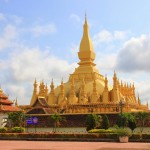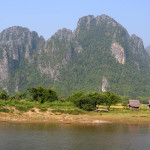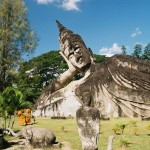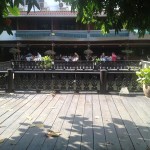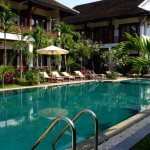People & population
– Population: 6.5 million.
– Density: 23 people/square kilometer.
– The population consists of 49 ethnic groups, in 4 main linguistic.
- The Lao-Tai Family includes 08 ethnic groups: Lao, Phouthai, Tai, Lue, Gnouane, Young, Saek and Thai Neua.
- The Mon-Khmer Family includes 32 ethnic groups: Khmu, Pray, Singmou, Khom, Thene, Idou, Bid, Lamed, Samtao, Katang, Makong, Try, Trieng, Ta-oi, Yeh, Brao, Harak, Katou, Oi, Krieng, Yrou, Souai, Gnaheune, Lavy, Kabkae, Khmer, Toum, Ngouane, Meuang and Kri.
- The Tibeto-Burmese Family includes 07 ethnic groups: Akha, Singsali, Lahou, Sila, Hayi, Lolo and Hor.
- The Hmong-Loumien category has 02 main tribes: Hmong and Loumien (Yao).These multi-ethnic people are scattered across the country each with their own unique traditions, culture and language.
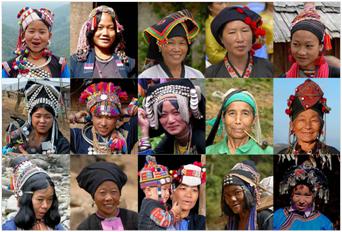
It is reckoned that Laos has somewhere between 70 to over 100 ethnic groups (no one can be sure!), and these are divided into four major cultural-linguistic collections. Hill tribes make up a significant proportion of the population, though precisely how many ethnic groups actually exist in Laos remains uncertain; figures range from a government list of 68 to estimates by independent ethnographers of 120 or more. Laos’ rich and complex linguistic mixture is such that, in extreme cases, some minorities consist of only a few hundred people, and only occupy a particular mountaintop or valley!
The Lao-Loom, or lowland Lao, speak Laotian Tai and live in the lowlands and cities and along the Mekong River. The Lao-Loom comprise about two-thirds of the country’s total population.
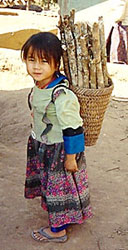
The Lao-Tai, or tribal Tai, include the Black Tai and Red Tai (so-called in reference to the colour of their women’s dress), who live throughout the country, especially at higher elevations
The Lao-Toong speak Mon-Khmer based languages, and are often termed the Austro-Asiatic people, (the largest group being the Kammu). These peoples are thought to be the descendants of the earliest peoples of the region; they live throughout Laos and in neighbouring countries, and their settlements are usually situated on the slopes at moderate elevations, and this pattern may have been due to immigration pressure by the early Lao who eventually took over the valleys.
The Lao-Soong group, including the Hmong (Meo, or Miao) and the Man (Yao), probably migrated from southern China to Laos in the late 18th century, and live in the mountains at the highest elevations, since most other land spaces had already been occupied at the time of their arrival.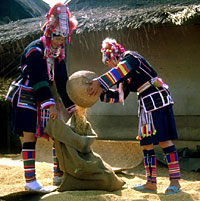
Each of these groups, and the divisions within them, have their own culture, but in this website most of the focus is on lowland Lao culture.
In the Plain of Jars area, the most numerous peoples are the lowland Lao, Hmong, Black Tai, and Kammu. The Puan people, the Lao of the Plain of Jars, are a group of lowland Lao whose language and customs are slightly different than the Lao Loom in other regions. However, in modern times, after frequent population movements in and out of the area, they have been assimilated into the mainstream Lao group, and their language, for all practical purposes, approximates the common Lao tongue, except for some vocabulary and tonal differences.
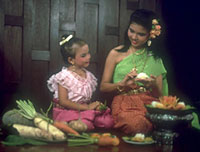
The lowland Lao share many similarities with the Thai people. Having a common origin, the language and customs are basically the same, while most of the differences between them are largely the result of the past 500 years of history, their destinies having taken contrasting paths.
One noticeable difference however, is the food. The Lao have a tradition of eating things raw, including game meat and buffalo and fish, and uncooked vegetables, many of them wild herbs, grasses, leaves, and roots. This could be attributed to the forested mountainous character of their environment. The type of rice Laotians eat is also distinctive – sticky, or glutinous rice – which is eaten by kneading a small handful into a ball and dipping it into a dish of condiments. Sticky rice is served in reed baskets with a tight fitting cover that slips on and off. When Lao go off to work in the fields or elsewhere you will often see hanging at their side a small version of these round woven baskets to carry their sticky rice, and perhaps a small amount of fish or meat which will serve as a mid-day meal. The most ubiquitous dish eaten with sticky rice is pa dek, a highly pungent fermented fish sauce. It is common to see on the back verandah of a Lao peasant’s house an earthenware jar of fermenting pa daek.
The second distinctive dish of the Lao is tam som (tam makhoong), which is a salad made from strips of unripe papaya, chilies, pieces of crab, little eggplants, and pa laa, another form of fermented fish. And then there is laap. It is made with fish, chicken, duck, pork, beef, buffalo or game meat. The meat and innards, often raw, are finely chopped and spiced with onion, chilies. and other herbs such as mint and lemon grass.


